Pressure in the water supply system of a private house: the specifics of autonomous systems + ways to normalize pressure
A device in the territory of a private home ownership or in the country house of an autonomous water source does not mean that this water can be comfortably used, and all hydraulic appliances and plumbing will be stably switched on and work reliably.
It is also necessary to ensure that the pressure in the water supply system of a private house is within optimal values, with the pressure required for domestic and household needs. And how to achieve this will be described below.
The content of the article:
Characteristic features of autonomous water supply systems
One of the most important characteristics of a water pressure system is water pressure. Not only the pressure in the tap depends on it, which makes it possible to carry out normal hygiene procedures without problems, but also the performance of all water-consuming devices and equipment.
It should be borne in mind that the functioning of an autonomous water pressure system is different from the centralized water supply of high-rise buildings.

There are some features in maintaining a stable optimum pressure of water produced from autonomous source.
The system of independent use of water sources of a country house includes interconnected elements:
- Pipelines, fittings, manometers.
- Submersible or a surface pump for lifting water from a source.
- Pumps that increase pressure, and there may be several, or a pumping station with a hydraulic accumulator to accumulate a reserve of water for the purpose of further uninterrupted water consumption.
- Turning on, if necessary, and turning off the relay pump.
Unlike residents of high-rise buildings, the owner of a private house has to solve issues related to the correct and effective interaction of all these elements.
Feature # 1 - raising water from a well
Water is taken and transported directly from the water supply source.
And there may be several options. But which one to prefer, mainly depends on the complexity and cost of lifting water to the surface. The most expensive are the artesian well and well.
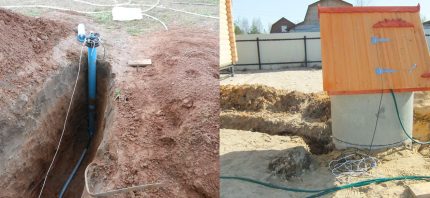
The first option - due to the need for deep drilling, using special equipment, the second - due to manual labor.
Bore needle, or abyssinian - the easiest source for the device with your own hands and less expensive equipment.
Each of these options has its pros and cons, and the choice depends not only on the price and complexity of the work, but also on the specific geological conditions of the area.
Feature # 2 - water withdrawal rate
The performance of the water supply system and the use of pumping equipment in it depends on the flow rate of the water source.
The correct calculation of the flow rate allows you to rationally use this source and correctly approach the issue pump selection.
The greater the ratio of the maximum possible volume of water for production from a well or a well to the unit of time for which the source will be exhausted, the higher the water intake capacity and, accordingly, the pump should be more powerful.
To determine the flow rate of the source, two water level indicators are used:
- Static - the length of the plot from ground level to water in the source at rest.
- Dynamic - the distance from the surface to the steady elevation of the water mirror when the pump unit is turned on.
If the amount of water pumped out from the source is stable at the level of its replenishment, then we can say that the water intake capacity corresponds to the pump capacity. With a good source flow rate, the difference between these two levels should not exceed 1 meter.
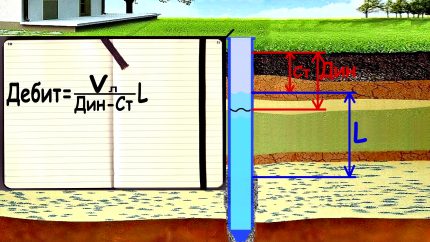
Pump capacity should not be higher than the flow rate of the source. Otherwise, a situation is possible in which, having pumped out all the water, a regular pump will continue to work “dry”. And this threatens his failure.
It is recommended to install the pump away from the filter, but so that a water level of at least 1 m always remains above it.
Feature # 3 - transporting water to consumers
The use of an autonomous source dictates the need to install pumping equipment not only to raise water from the aquifer, but also to create a pressure sufficient for pumping it through pipelines and subsequent distribution throughout the house at various levels.
Do not forget about irrigation and fire extinguishing systems, the work of which must be provided with the appropriate pressure.
When choosing pumping units, it is necessary to take into account the pressure-reducing hydraulic resistance of the pipes, which directly affects the water flow rate. And the longer the communication path from the source to the house and the end consumer, the greater this resistance becomes.
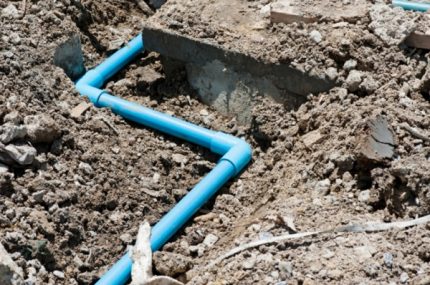
Therefore, for an autonomous water supply, it is necessary to take into account not only the size of the worker, i.e.fixed in standard conditions pressure in the water supply system of the house, but also design - the maximum excess pressure.
Based on the values of the calculated pressure, water pipes with appropriate diameters and wall thicknesses are selected. All this affects the reliability, efficiency and durability of a decentralized water supply system.
Basic water pressure standards
The pressure values in the water supply system, both cold and hot water, are regulated by a special set of rules and SNiPs. There are no separate standards applicable only to private houses for water pressure at the entrance to the house or at the points of its analysis.
According to general rules, the lower pressure limit at the level of the first floor of the house should be 1 atmospheric unit or 1 Bar. This value corresponds to the pressure that allows you to create a 10-meter column of water.
If the house has several floors, then to calculate the input pressure, 4 m of water column or 0.4 atm is added to each floor.
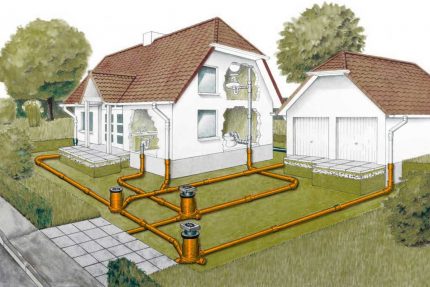
You need to know that water, machinery, appliances and sanitary equipment have individual standards that define the minimum indicators water pressurein which the normal functioning of these devices is ensured.
Sanitary technology:
- 0.2 atm - washbasin, toilet;
- 0.3 atm - bath, shower, bidet;
- 0.4 atm - Jacuzzi and hydromassage equipment.
Appliances:
- 1,5 atm - a dishwasher;
- 2 atm - washing machine.
Other water consumers:
- 1,5 atm - fire extinguishing system
- 2 atm - heating boiler, taking into account the parameters of the heating system;
- 3,5 atm - watering system.
In order for the equipment to work at the limit of its characteristics and function normally, it is necessary to add another 0.5 atm to the nominal passport values.
And you can determine the pressure in the water supply system using manometers. These devices can be installed at the entrance to the house, and they are also equipped with pumping stations, which will be discussed below.
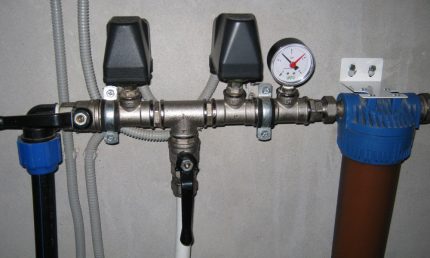
Pressure Increasing Methods
The construction of a water supply system, like any other construction, begins with a project. Therefore, the question of equipping the system with the necessary pumping and other equipment to maintain optimal pressure in it, it is preferable to work out and calculate at the design stage.
If the pressure drop in the water supply system occurred during its operation, first of all, it is necessary to establish the possible causes of the malfunction.
To do this, an audit is carried out inside the circuit and the main elements of the water supply scheme for defects or miscalculations.
These may include:
- improper selection of pumping equipment performance;
- design errors made during the installation of the system;
- leaks and fistulas in the pipelines themselves or at their joints;
- reduction in pipe clearance due to deposits formed as a result of long-term operation;
- pollution of filter elements;
- malfunctioning valves.
There are several ways to force increase the pressure of water in a private water supply system, both newly built and existing.
Method # 1 - using a circulation pump
This method will give the desired effect if the pressure in the water supply needs to be increased by 1-2 atm. To implement it, you will need to additionally purchase circulation pump.
The principle of operation of such a unit is to create pressure differences due to centrifugal force in the pump chamber, as a result of which water through the pump outlet enters the system already with increased pressure.The process takes place with continuously repeating cyclicality.
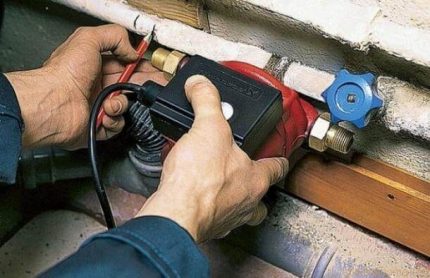
The main characteristics that you should pay attention to when choosing such a device are:
- the pressure of water provided at the exit;
- the ability to work in manual and automatic modes;
- noise component;
- rotor type.
According to the principle of operation of the rotors, the devices are divided into wet and dry type pumps.
In the first case, the movement of water in the system is realized due to the rotating impeller blades, which is mounted on the rotor shaft. Cooling and lubrication of the working elements of the pump is carried out naturally due to the water flow.
This feature gives the device great advantages over other types of pumps.
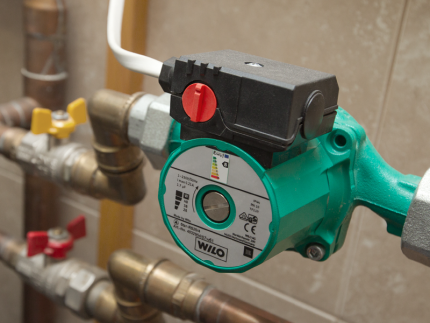
The efficiency of the wet rotor unit is not very high - 45%, but this device is a worthy option for domestic use.
In the second version, a more efficient dry type pump is installed on the common line.
The pump motor is mounted outside the pipe and has no contact with the fluid. It is cooled by air. Such units may differ among themselves in the type of connection to the engine and the place of its installation.
The efficiency of this type of pump is much higher - about 70%, which makes it appropriate to use it if it is necessary to create a higher pressure in the system and, if, the flow pump performance is not enough.
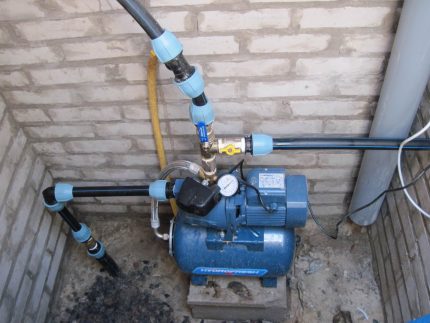
As a conclusion, for a small increase in water pressure, including on the inlet to a separate household appliance or sanitary equipment, it is advisable to use a less powerful flow unit.
Installation of circulation pumps on the water supply system is not a big deal. The main thing is that the installation is carried out taking into account the direction of operation of the impeller indicated on the device - in the direction of movement of the water.
In the modern market, Wilo, Grundfos, Oasis, Gileks pumps are in demand. A large number of offers allows for an affordable price to choose a unit with the desired characteristics in terms of pressure, performance, dimensions, noise and other indicators.
The nozzles of all devices are unified for installation on Russian water supply networks.
Method # 2 - water station equipment
The equipment of a home pumping station is more expensive, but modern and will definitely solve the issue of providing a private or country house with water with optimal pressure.

The water installation includes five main elements:
- Electric motor
- Self priming pump.
- Storage tank.
- Pressure switch.
- Non-return valve.
To create a supply of water, a conventional storage tank or a factory tank can be included in the system. accumulator membrane type.
Pump station with tank - This option is somewhat outdated and not very convenient due to the need to have too large capacity in the station. And the pressure of the water, which is taken by gravity, will depend on the height of the tank.
This entails a problem such as choosing a place to place the water tank on the attic or higher floor than water consumers. In addition to installation inconveniences, the risk of flooding of the rooms located below is also increased in the event of any malfunction.
Despite these drawbacks, such a system of increasing pressure in the water supply system has been used for a long time in private homes, and is also widely used in the construction of a new water supply system.
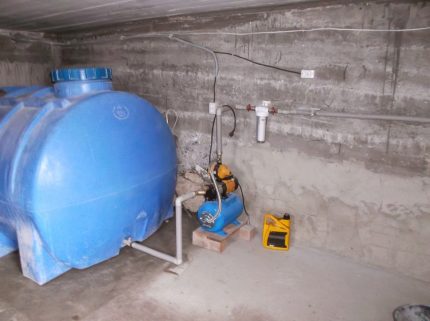
A tank is monitored during water analysis by a relay that automatically starts the pump when the level drops and, accordingly, the water pressure in the tank drops to a certain value. When replenishing the supply of water, the pressure in the tank increases and, having reached the maximum set value, the pump turns off. The cycle repeats.
Accumulator home station. This is a more advanced and modern equipment in autonomous water supply. The station’s complete set contains a hydraulic accumulator, another name is a membrane tank.
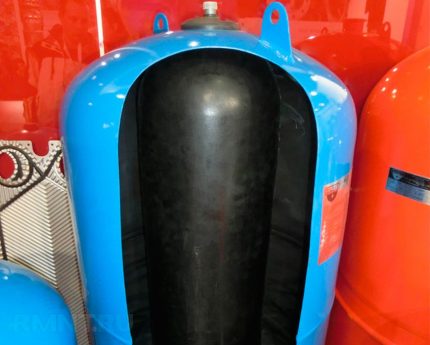
The membrane material is sanitary safe and is suitable for storing drinking water according to hyena standards. The principle of operation of the hydraulic accumulator implies the possibility under pressure of the water pumped into the membrane by the pump to increase its volume, thereby increasing the air pressure in the second chamber.
When the pressure increases to a threshold value, the relay switches off the pump. The decrease in pressure in the chamber during the analysis of the water forces the relay to restart the pump.
The membrane tank has an air valve, the pressure on which should be 1.5-2 atm. The valve is designed like a regular automobile nipple, which makes it possible to manually adjust the pressure in the air compartment.
Advantages of a pumping station with a hydraulic accumulator:
- the possibility of equipment at any level of a private house;
- increase in operational resource of the pump;
- creating relatively even pressure in the water supply;
- accumulation of fluid in the event of an emergency power outage.
When installing the pumping station, it is desirable to place the accumulator in such a way that it has easy access to it, which allows for preventive maintenance or repair without draining the water from the system.
For more information on how to choose a pumping station for a private house, read Further.
Pressure stabilization in a water supply system
For the water supply system of a country house to be stably uniform in pressure, the presence of only a membrane tank in the circuit is not enough and the probability water hammer remains big.
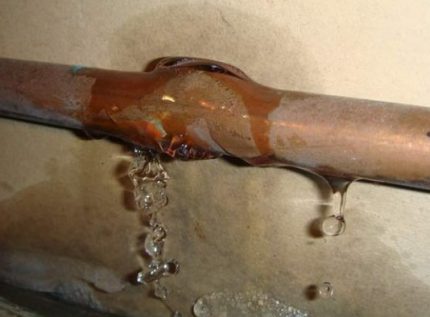
Another reason that justifies the need for forced stabilization of water pressure is the possibility of increasing it at various water points of the system while simultaneously operating. For this purpose, you can use a frequency converter.
For example, in the absence of a device equalizing the pressure of water, if one person is washed in the shower and another is watering the garden at this time, then the water pressure will be divided in half.
Advantages of the frequency converter:
- the pressure of the water is kept stable during the whole time of water consumption;
- the pump operates in smooth start and stop modes, which increases its service life by 1.5 times;
- dry running protection of the pump;
- hibernation significantly saves electricity;
- the possibility of reducing the volume of the membrane tank by almost 10 times.
In addition to saving space, a small tank eliminates unpleasant odors associated with stagnation of water. Modern pumps and stations can already be bought with a built-in frequency converter.

But integrating a separately purchased converter into the water supply system is quite simple. The main thing in choosing it is to take into account compatibility with such characteristics of existing equipment as power, supply voltage and current strength.
Conclusions and useful video on the topic
The video, the author of which shares his advice on increasing the water pressure in a private house with the help of a self-built pump station with a storage tank:
Video about the nuances of connecting a hydraulic accumulator to the water supply system of a private house and adjusting the air pressure in it:
A video telling about the advantages of a frequency converter in a water supply system with instructions for use and a description of its operation modes:
Normal water pressure in an autonomous system is an essential condition for a comfortable and reliable operation of the water supply system. Living in your own home or at the cottage dictates the conditions under which the most ordinary person should be an expert in many matters.
Knowing the simple foundations of the theory of water pressure in an independent water supply system and following the advice given on how to make it stable will give only positive results. This will avoid possible miscalculations at the planning stage and during work on the installation of an autonomous water supply system, will help to correctly determine the acquisition of the necessary equipment.
If you want to ask a question on the topic of the article or have valuable knowledge that will help normalize the water pressure in the system, please leave your comments in the block below.

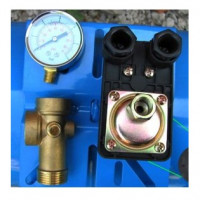 Water pressure sensor in the water supply system: specifics of use and adjustment of the device
Water pressure sensor in the water supply system: specifics of use and adjustment of the device 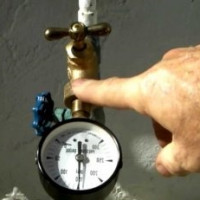 Standards for water pressure in the water supply in an apartment, methods for measuring and normalizing it
Standards for water pressure in the water supply in an apartment, methods for measuring and normalizing it 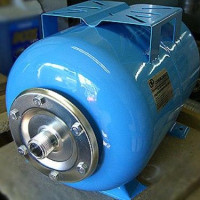 Hydraulic accumulator: device and principle of operation of a hydraulic tank in a water supply system
Hydraulic accumulator: device and principle of operation of a hydraulic tank in a water supply system 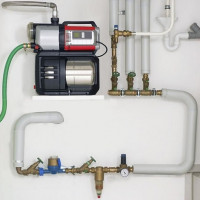 Pumping station for a private house: how to choose and what to look at before buying
Pumping station for a private house: how to choose and what to look at before buying 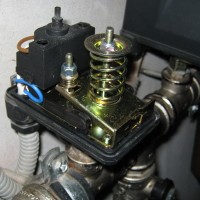 Adjusting the pressure switch for the accumulator: instructing on the equipment setup + expert advice
Adjusting the pressure switch for the accumulator: instructing on the equipment setup + expert advice 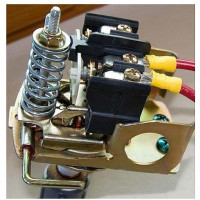 How a pressure switch for a pumping station works + rules and features of its adjustment
How a pressure switch for a pumping station works + rules and features of its adjustment  How much does it cost to connect gas to a private house: the price of organizing gas supply
How much does it cost to connect gas to a private house: the price of organizing gas supply  The best washing machines with dryer: model rating and customer tips
The best washing machines with dryer: model rating and customer tips  What is the color temperature of light and the nuances of choosing the temperature of the lamps to suit your needs
What is the color temperature of light and the nuances of choosing the temperature of the lamps to suit your needs  Replacement of a geyser in an apartment: replacement paperwork + basic norms and requirements
Replacement of a geyser in an apartment: replacement paperwork + basic norms and requirements
No need to recall this old standard of 1.0 atm. In fact, part of the equipment will not work with such pressure. A washing machine, dishwasher, instantaneous water heaters (both electric, that geysers) - all require more pressure. And just for a normal soul more is needed. According to SNIP - 0.3-6.0 for cold water, in real life - at least two, and preferably three or four.
Faced this problem recently in my country house and realized that the company that was installing the autonomous water supply did not take care of stabilizing the pressure. And when we moved there to live, the problem became obvious. I had to re-contact the specialists who installed the frequency converter. The problem was resolved right away.